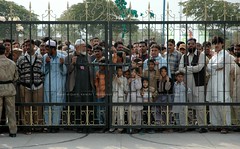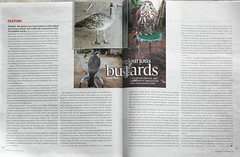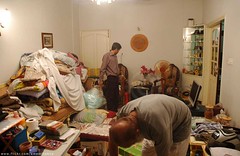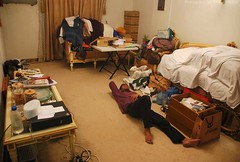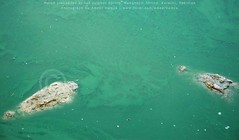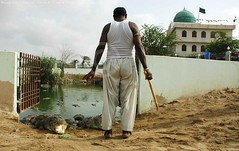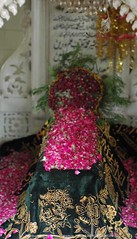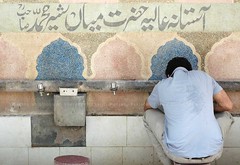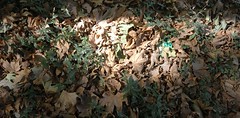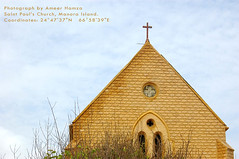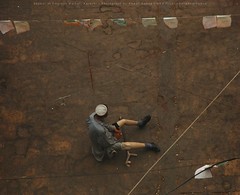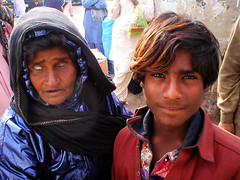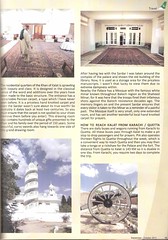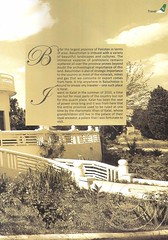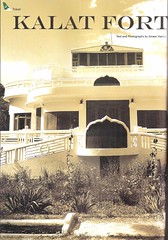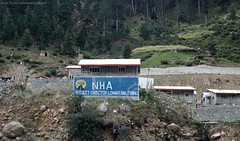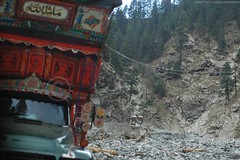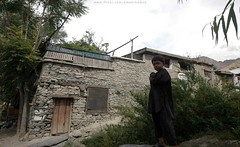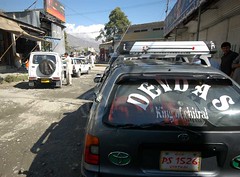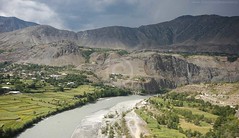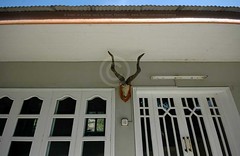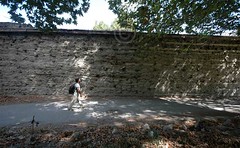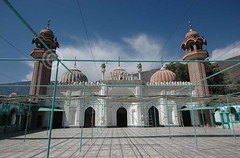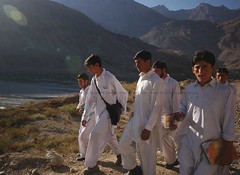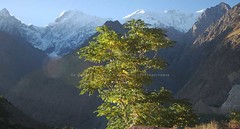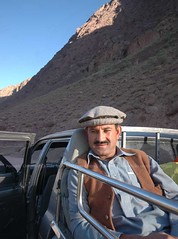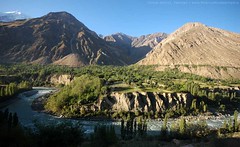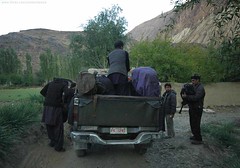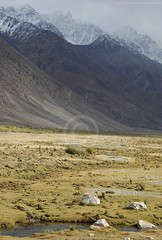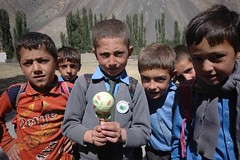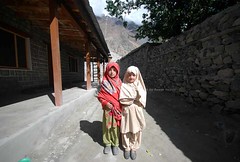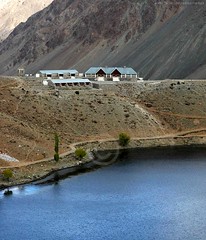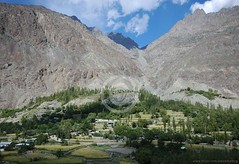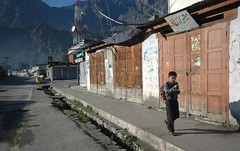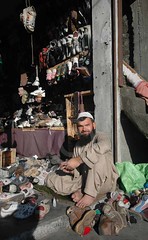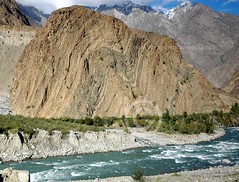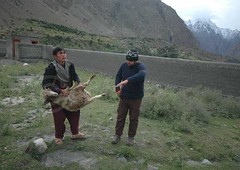On a question recently put across on the board by Pakistan Blog Awards team to all of us bloggers, 'What would every bloggers message be for Pakistan, this 25th of December, our Founding Father's birthday?', I put up this photograph, shot by me on 25th Dec, 2006, by my good Nikon and with due permission from a good, old friend in Pakistan Army. Here is what I wrote after uploading this photograph:
Via Flickr:
During the celebrations of the Birthday anniversary of Leader and Founder of Pakistan, Muhammad Ali Jinnah, common men were asked to stand outside the main gate while the VIP's (Read: Dacoits and Politicians) prayed and socialized over the dead body of their leader.
I am always ashamed by the workings of this country and its politicians when I see this photograph. This country was not made for looters and politicians and army junta. It was made for common Muslims, Hindus, Sikhs, Christians and for Parsis and for those who would like to live their life according to their own wishes. Unfortunately for the man who created it and for all of us, we now find ourselves among the angry mullahs and the duck-headed leaders.
- You got the point.
Tuesday, November 29, 2011
Sunday, November 27, 2011
Published: Express Tribune Mag Nov 27- Dec 3, 2011
Article by Adil Mulki
Photographs by Ameer Hamza
As so happens with so many Pakistan-based publications, the editors really don't consider publishing the name of the photographer(s). And that is a sad reality and reflects the general thinking among the editors here: Photographs are not as important as a write-up. They are wrong. And everyone else is wrong who considers photographs as secondary. You just need to pick any issue of National Geographic.
You may read the wonderfully penned article here:
'Outside, the desert sun beats down on the baked and barren dunes, but inside the customised SUV, it’s another world. The AC is on full blast and the tinted windows filter the unforgiving rays of the sun into diffused light. Plush seats provide a level of comfort one would find impossible to imagine in such a harsh environment. Beep…beep…beep. The silence is broken by the sound of the scanner; the vehicle comes to a sudden halt, sending the soft desert sands cascading down the dune that it is now precariously perched atop.'
More...http://tribune.com.pk/story/296325/inglourious-bustards/#comment-437326
Photographs by Ameer Hamza
As so happens with so many Pakistan-based publications, the editors really don't consider publishing the name of the photographer(s). And that is a sad reality and reflects the general thinking among the editors here: Photographs are not as important as a write-up. They are wrong. And everyone else is wrong who considers photographs as secondary. You just need to pick any issue of National Geographic.
You may read the wonderfully penned article here:
'Outside, the desert sun beats down on the baked and barren dunes, but inside the customised SUV, it’s another world. The AC is on full blast and the tinted windows filter the unforgiving rays of the sun into diffused light. Plush seats provide a level of comfort one would find impossible to imagine in such a harsh environment. Beep…beep…beep. The silence is broken by the sound of the scanner; the vehicle comes to a sudden halt, sending the soft desert sands cascading down the dune that it is now precariously perched atop.'
More...http://tribune.com.pk/story/296325/inglourious-bustards/#comment-437326
Saturday, November 26, 2011
My home before my wedding
Date: 2nd February, 2009.
Location: My home, Karachi.
Via Flickr:
More work next day: My father (foreground, bending) checks out something as my brother, Ovais, looks for space amidst hoards of items stacked onto one another. Marriage is one big game in Pakistan, which you have to play. And everyone is required to help you out. You can just imagine the predicament of my parents and my siblings in re-arranging all the stuff, just in time for my wedding on 20th March, 2009. This photograph is a reminder of all that transpired.
Location: My home, Karachi.
Via Flickr:
More work next day: My father (foreground, bending) checks out something as my brother, Ovais, looks for space amidst hoards of items stacked onto one another. Marriage is one big game in Pakistan, which you have to play. And everyone is required to help you out. You can just imagine the predicament of my parents and my siblings in re-arranging all the stuff, just in time for my wedding on 20th March, 2009. This photograph is a reminder of all that transpired.
My home before my wedding
Date: 1st February, 2009.
Location: My home, Karachi.
Via Flickr:
My wedding took place on 20th March, 2009. But before that lot of shifting was done to create space for my incoming stuff, what you call jahez furniture (dowry), and assortment of items. This is my brother, Ovais Adhia, sleeping after spending a day full of work, both at office and at home.
Location: My home, Karachi.
Via Flickr:
My wedding took place on 20th March, 2009. But before that lot of shifting was done to create space for my incoming stuff, what you call jahez furniture (dowry), and assortment of items. This is my brother, Ovais Adhia, sleeping after spending a day full of work, both at office and at home.
Friday, November 25, 2011
Daily Life: Washing at Sufi Shrine, Karachi
Date: 3rd June, 2007.
This was a good day for photography. Some great shots came through. I particularly like this one. It is full of a typical life around this Shrine of Pir Haji Syed Sakhi Sultan (RA). The hot sulphur spring water, from whose water these two men are bathing, is known to cure skin ailments. And there could be some truth in this: We know from various scientific studies that sulphur waters from spring may cure certain diseases; it also helps to make you fresh as an orange. I tried that too and was happy with the results. But not this time. I think these two men were initially embarrassed that a photographer had popped from nowhere, clicking away continuously.
I also like the worn down structure to the left of the frame, the keekar trees, the un-plastered wall, and one of the men pulling down his shalwar; other one was probably waiting for me to move out before he could remove his shalwar. I moved away. Thanks to me!
This was a good day for photography. Some great shots came through. I particularly like this one. It is full of a typical life around this Shrine of Pir Haji Syed Sakhi Sultan (RA). The hot sulphur spring water, from whose water these two men are bathing, is known to cure skin ailments. And there could be some truth in this: We know from various scientific studies that sulphur waters from spring may cure certain diseases; it also helps to make you fresh as an orange. I tried that too and was happy with the results. But not this time. I think these two men were initially embarrassed that a photographer had popped from nowhere, clicking away continuously.
I also like the worn down structure to the left of the frame, the keekar trees, the un-plastered wall, and one of the men pulling down his shalwar; other one was probably waiting for me to move out before he could remove his shalwar. I moved away. Thanks to me!
Wednesday, November 23, 2011
Marsh crocs at Hot sulphur springs, Karachi
Via Flickr:
Danger lurks around every corner of the frame: Nile delta marsh crocodiles pop their heads out of the hot sulphur spring found at the Shrine of Sufi Saint, Hazrat Pir Haji Sakhi Sultan (RA). This surely is one of the most fascinating places in the country and surely the oldest Sufi Shrine in Karachi.
For detailed reading of this interesting subject, you must read the following article / blog:
http://pakistaniat.com/2009/06/18/the-mysteries-of-manghopir-shrine-crocodiles-and-sulphur-springs-part-1/
Danger lurks around every corner of the frame: Nile delta marsh crocodiles pop their heads out of the hot sulphur spring found at the Shrine of Sufi Saint, Hazrat Pir Haji Sakhi Sultan (RA). This surely is one of the most fascinating places in the country and surely the oldest Sufi Shrine in Karachi.
For detailed reading of this interesting subject, you must read the following article / blog:
http://pakistaniat.com/2009/06/18/the-mysteries-of-manghopir-shrine-crocodiles-and-sulphur-springs-part-1/
Feeding marsh crocodiles at Sufi Shrine, Karachi
Date: 3rd June, 2007.
This is Sheedi, or black man, standing among the most dangerous crocodiles on Earth: Marsh crocodiles from River Nile. No one knows how they ended up here, thousands of miles from their original place, in the barren of Karachi at a Sufi Shrine near Karachi (now Manghopir, as this place is called, is part of Karachi due to horizontal expansion of the city).
The legend is that these crocodiles are actually lice of the Saint, who threw them into this spring. And they became crocodiles!
This is Sheedi, or black man, standing among the most dangerous crocodiles on Earth: Marsh crocodiles from River Nile. No one knows how they ended up here, thousands of miles from their original place, in the barren of Karachi at a Sufi Shrine near Karachi (now Manghopir, as this place is called, is part of Karachi due to horizontal expansion of the city).
The legend is that these crocodiles are actually lice of the Saint, who threw them into this spring. And they became crocodiles!
Tuesday, November 22, 2011
Shrine of Hazrat Mian Sher Muhammad, Sharakpur Sharif
Date: 8th June, 2011.
And then, after performing wuzu, we entered the small, peaceful, re-constructed shrine of Hazrat Mian Sher Muhammad. Inside, in a small room there were three graves of which one is here photographed. I had my 50mm on which did not allow me enough space to shoot. The place was good and the heat, which was outside now raging, was in control here. Birds were chirping and few people, among them the caretaker of the Shrine, were present. All were in awe of the Saint. I was happy that I was here. I have always respected Saints because it is due to their tireless efforts that most of us are Muslims. We prayed silently, I took further photographs, and then we moved on.
I was soon reminded by father of Haroon, who was with me for the first time on any trip, that it was the day of Haroon's shadi and we better get to Lahore in time. And so we hurried off....
And then, after performing wuzu, we entered the small, peaceful, re-constructed shrine of Hazrat Mian Sher Muhammad. Inside, in a small room there were three graves of which one is here photographed. I had my 50mm on which did not allow me enough space to shoot. The place was good and the heat, which was outside now raging, was in control here. Birds were chirping and few people, among them the caretaker of the Shrine, were present. All were in awe of the Saint. I was happy that I was here. I have always respected Saints because it is due to their tireless efforts that most of us are Muslims. We prayed silently, I took further photographs, and then we moved on.
I was soon reminded by father of Haroon, who was with me for the first time on any trip, that it was the day of Haroon's shadi and we better get to Lahore in time. And so we hurried off....
Making ablutions at Shrine of Hazrat Mian Sher, Sharakpur Sharif
Date: 8th June, 2011.
This is my friend and travel partner, Adeel, making Wuzu (Islamic ablutions) at the Mazar / Shrine of Hazrat Mian Sher Muhammad. About him, one website has this to say, 'Hazrat Mian Sher Muhammad was one of the famous Saints of Punjab who got a reputation in Naqshbandiyyah Series (Silsala). He was born as a saint.' ..... And, 'With his blessings many dead hearts were lightened with divine light. Even still now his name is called with respect and devotion.
The Naqshbandy forefathers of Hazrat Mian Sher Muhammad migrated from Kabul to Punjab and lived in Qasoor. Then migrated from Qasoor to Hujra Shah Makeem and then Sharaqpur. The father’s name of Hazrat Mian Sher Muhammad was Mian Aziz Aladdin. His ethnicity was Arian. His family’s professional business was cultivation. Hazrat Mian Sher Muhammad was born in Sharaqpur in 1865 CE (1282 H). After his birth from his body and shining face, the symptoms of as a saint were clear.'
You may read full details about this and other Saints of Sharaqpur Sharif (Lonely Planet Guide to Pakistan pronounces it as 'Sharakpur' Sharif).
http://www.sharaqpur.com/Hazrat_Mian_Sher_Muhammad.aspx
It is essential part of Sunni Barelvi belief system that before entering graveyard (qabar'istan) and therefore, any Tomb / Shrine, one must be ritually pure. Therefore, we Sunni Barelvis make wuzu before making our hazri (appearance) in front of Sufi Saint.
This is my friend and travel partner, Adeel, making Wuzu (Islamic ablutions) at the Mazar / Shrine of Hazrat Mian Sher Muhammad. About him, one website has this to say, 'Hazrat Mian Sher Muhammad was one of the famous Saints of Punjab who got a reputation in Naqshbandiyyah Series (Silsala). He was born as a saint.' ..... And, 'With his blessings many dead hearts were lightened with divine light. Even still now his name is called with respect and devotion.
The Naqshbandy forefathers of Hazrat Mian Sher Muhammad migrated from Kabul to Punjab and lived in Qasoor. Then migrated from Qasoor to Hujra Shah Makeem and then Sharaqpur. The father’s name of Hazrat Mian Sher Muhammad was Mian Aziz Aladdin. His ethnicity was Arian. His family’s professional business was cultivation. Hazrat Mian Sher Muhammad was born in Sharaqpur in 1865 CE (1282 H). After his birth from his body and shining face, the symptoms of as a saint were clear.'
You may read full details about this and other Saints of Sharaqpur Sharif (Lonely Planet Guide to Pakistan pronounces it as 'Sharakpur' Sharif).
http://www.sharaqpur.com/Hazrat_Mian_Sher_Muhammad.aspx
It is essential part of Sunni Barelvi belief system that before entering graveyard (qabar'istan) and therefore, any Tomb / Shrine, one must be ritually pure. Therefore, we Sunni Barelvis make wuzu before making our hazri (appearance) in front of Sufi Saint.
Monday, November 21, 2011
Portrait: Shoemaker, Old city of Sharkapur Sharif
Date: 8th June, 2011.
Another trip, another sweltering heat, another place, another interesting person. This time it is Central Punjab (or is it just Punjab?) and we are here - me, Haroon's father and Adeel - at an old town of Sharakpur Sharif (also pronounced and written as, 'Sharaqpur'). And the first interesting person we see is this cobbler / shoemaker sitting on a pavement just outside the old city gate (there are three or four of these left now), polishing the Peshawari sandal. I say my salam and take his photograph but his response, unlike many there, is lukewarm. He isn't smiling at all. But he allows me the frame. I use 50mm for this frame and I think it just came out nicely.
Another trip, another sweltering heat, another place, another interesting person. This time it is Central Punjab (or is it just Punjab?) and we are here - me, Haroon's father and Adeel - at an old town of Sharakpur Sharif (also pronounced and written as, 'Sharaqpur'). And the first interesting person we see is this cobbler / shoemaker sitting on a pavement just outside the old city gate (there are three or four of these left now), polishing the Peshawari sandal. I say my salam and take his photograph but his response, unlike many there, is lukewarm. He isn't smiling at all. But he allows me the frame. I use 50mm for this frame and I think it just came out nicely.
Pakistani truck, Indus Highway, Sindh
We were going to Sehwan Sharif. I think we were four then: Me, Suffian Adhia, Raja Islam and Uzair Tahir. Or, maybe, one of the last two were missing. I cannot now recall because I don't have a group photograph. But I can very clearly recall the heat outside the car. The heat of Sindh is remarkable: It can kill you instantly.
This decorated truck was moving slowly in front of our speeding car. Being a double track (2-way traffic) the incoming cars were not allowing any space to move ahead of this truck. I took advantage of this situation and took the shot using, perhaps, Raja's Canon. I am happy with the results. And I am always happy when I see well maintained, decorated Pakistani trucks on the road. They are a moving form of cultural / folk art.
This decorated truck was moving slowly in front of our speeding car. Being a double track (2-way traffic) the incoming cars were not allowing any space to move ahead of this truck. I took advantage of this situation and took the shot using, perhaps, Raja's Canon. I am happy with the results. And I am always happy when I see well maintained, decorated Pakistani trucks on the road. They are a moving form of cultural / folk art.
Sunday, November 20, 2011
Chestnut tree leaves, Chitral
In my diary style reporting on the latest trip (9th September, 2011 - 25th September, 2011) I did not mention this photograph of chestnut tree leaves lying on the garden just outside the Chitral Fort.
I like this photograph very much. Firstly, because a traveller to Chitral MUST never miss them. This tree epitomizes the stature of the man in Chitrali society. I was informed by a local Chitrali that every self-respecting must have this tree in his home garden. By that definition, the most powerful and rich man in Chitral, the Mehtar of Chitral (former rulers) should have lots of good chestnut trees. And sure enough there are those large, over 100-years old, grand chestnut trees all over the place. Their size must be understood via this frame of giant leaves on the floor.
I like this photograph very much. Firstly, because a traveller to Chitral MUST never miss them. This tree epitomizes the stature of the man in Chitrali society. I was informed by a local Chitrali that every self-respecting must have this tree in his home garden. By that definition, the most powerful and rich man in Chitral, the Mehtar of Chitral (former rulers) should have lots of good chestnut trees. And sure enough there are those large, over 100-years old, grand chestnut trees all over the place. Their size must be understood via this frame of giant leaves on the floor.
Friday, November 18, 2011
Nature : Marine Turtles, Hawksbay, Karachi
Via Flickr:
One of the most magnificent species from the sea and from the land, Marine turtles defy common logic and much else to live their long, adventurous, often hazardous lives on oceans and on selected beaches of the world. They are a lovely creature full of enthusiasm for life and for their beautiful kids.
Their story begins much before they are born. Their mothers, totally aware of issues related to protection of species, lay many eggs. Many eventually won't turn out turtles at all. Some will be eaten by stray dogs, or crows or eagles. Others would be gulped down by various sea species. The left behind turtles would eventually grow up to become the mothers and fathers of this wonderland. They would, in their lifetime, travel thousands of kilometers to feed and to nest.
Pakistan's Sand spit beach (also called Turtle beach) is one of the rare nesting grounds for two species of Marine turtles, the Olive Ridley Turtle (Lepidochelys olivacea) and the Green Turtle (Chelonia mydas).
One of the most magnificent species from the sea and from the land, Marine turtles defy common logic and much else to live their long, adventurous, often hazardous lives on oceans and on selected beaches of the world. They are a lovely creature full of enthusiasm for life and for their beautiful kids.
Their story begins much before they are born. Their mothers, totally aware of issues related to protection of species, lay many eggs. Many eventually won't turn out turtles at all. Some will be eaten by stray dogs, or crows or eagles. Others would be gulped down by various sea species. The left behind turtles would eventually grow up to become the mothers and fathers of this wonderland. They would, in their lifetime, travel thousands of kilometers to feed and to nest.
Pakistan's Sand spit beach (also called Turtle beach) is one of the rare nesting grounds for two species of Marine turtles, the Olive Ridley Turtle (Lepidochelys olivacea) and the Green Turtle (Chelonia mydas).
Heritage: Saint Paul's Church, Manoora, Karachi
Via Flickr:
Saint Paul's Church, Manora Island, Karachi, Pakistan.
It is a Protestant Church located at Coordinates: 24°47'37"N 66°58'39"E
Saint Paul's Church, Manora Island, Karachi, Pakistan.
It is a Protestant Church located at Coordinates: 24°47'37"N 66°58'39"E
Work: Begging at Empress Market
Via Flickr:
Begging at Karachi's premier market, Empress. Poverty is on the rise as inflation breaks new records, as more and more firms are closed down, and as more Pakistanis leave the country for good. Further afield, many Afghans are pouring down with no limbs or no hands or both, courtesy Soviet era land mines, which have devastated entire families and a way of life. Nine out of ten chances are that this beggar belongs to Afghanistan.
Begging at Karachi's premier market, Empress. Poverty is on the rise as inflation breaks new records, as more and more firms are closed down, and as more Pakistanis leave the country for good. Further afield, many Afghans are pouring down with no limbs or no hands or both, courtesy Soviet era land mines, which have devastated entire families and a way of life. Nine out of ten chances are that this beggar belongs to Afghanistan.
Portrait: Blind faqir, Jamshoro
It's September, its sweltering and it's 2006. General Musharraf is at the peak of his power but somehow the PPP wallahs and the courts are somewhat not easy with him. Pakistan's economy is shooting like hell. We are hearing the new money stars: Aqueel Karim Dadi, the Machyaras, the Mengals, the Sardars, Baloch nationalists... but where are the poor?
Here they are, in this frame. I love this frame for what it is. And I am doubly happy that it won a coveted Guardian (London) photography award. The editor at Guardian had this to say on this shot:
" 'Meet the Faqirs' stars grumpy Robert De Niro as a retired CIA operative who is relocated to Pakistan. Once there, he falls in with a wise blind grandmother and her soulful offspring - committed ascetics who have sworn off wordly possessions in their quest for spiritual enlightenment." '
There's nothing more left to say on this!
Here they are, in this frame. I love this frame for what it is. And I am doubly happy that it won a coveted Guardian (London) photography award. The editor at Guardian had this to say on this shot:
" 'Meet the Faqirs' stars grumpy Robert De Niro as a retired CIA operative who is relocated to Pakistan. Once there, he falls in with a wise blind grandmother and her soulful offspring - committed ascetics who have sworn off wordly possessions in their quest for spiritual enlightenment." '
There's nothing more left to say on this!
Thursday, November 17, 2011
Lowari Tunnel, NHA Office, Pakistan
This photograph marks the end of my photography session of the entire trip, which stretches from our trek till this place. The heat had vanished suddenly, heavy clouds were hovering around and there was this general feeling that the place was tense but exceedingly beautiful. I was informed at this checkpost that all foreigners are now banned from visiting this place anymore due to espionage problems. Even Pakistanis - all of them and without any distinction - are stopped here and asked to produce their ID cards. Additionally, we were asked to delete all photographs of nearby places. I questioned the rationale here because, if you search google.com and flickr.com, then you will come across hundreds of photographs of this beautiful place. I let it pass and so did Zahid bhai. But Zahid bhai was also able to take the frame of Pakistan-Afghanistan border.
Way to Lowari tunnel and top, Pakistan
And we were here, almost. We could just make out the haze surrounding the famed Lowari top. I could have been dreaming. The Pakistani trucks, decorated like brides, coming towards us in a single, slow, steady file. We weren't allowed to take the photograph of this very sensitive place. Our driver had told us to take photographs but discreetly. But the Army wallah had specifically requested us to avoid them altogether. Our ID cards had now been seen more times than in all of our 12-day trip previously. There was certainly something wrong with this place or the sensibilities. And then, I was reminded by our friend that during past Eid 250 Pakistani madrassah boys had been kidnapped by Taliban from across Afghanistan. More recently they had killed lot of Pakistani soldiers here. Understandably, photography was not permitted.
From Chitral to Lowari Pass
Date: 23rd Sep, 2011.
And our Toyota passed numerous mountains, people and places before coming to a screeching halt outside this stone place. I wasn't sure why until our driver informed us that new driver will take his place, instead. He would be sleeping in the trunk!
Whilst all preparations were taking place, we bargained for the pomegranates (5 Kg for Rs.350, no less); and I took this frame of a boy outside his stone home. This was also the home of our new, youngish driver. I cannot recall the name of the driver now. We picked up the speed again...
And our Toyota passed numerous mountains, people and places before coming to a screeching halt outside this stone place. I wasn't sure why until our driver informed us that new driver will take his place, instead. He would be sleeping in the trunk!
Whilst all preparations were taking place, we bargained for the pomegranates (5 Kg for Rs.350, no less); and I took this frame of a boy outside his stone home. This was also the home of our new, youngish driver. I cannot recall the name of the driver now. We picked up the speed again...
Chitral, Pakistan: Toyota everywhere
The photograph before this upload, that of Ayun valley, was taken after jumping out from this Toyota station wagon. In fact, everyone had jumped out of this vehicle to take that previous frame. A personal touch won't be out of place.
But I had forgotten to upload this photograph before. I wanted to share with you this DEVDAS and 'King of Chitral'; the PS number plate indicates that the custom had not been paid on this one and that it cannot be taken out of this province. Period. But you now know that the provincial government supports active rather than passive smuggling of vehicles.
This is Chitral and this frame was shot just before leaving the place.
But I had forgotten to upload this photograph before. I wanted to share with you this DEVDAS and 'King of Chitral'; the PS number plate indicates that the custom had not been paid on this one and that it cannot be taken out of this province. Period. But you now know that the provincial government supports active rather than passive smuggling of vehicles.
This is Chitral and this frame was shot just before leaving the place.
Tuesday, November 15, 2011
Places in Pakistan: Ayun valley, Chitral dist.
Via Flickr:
September 23, 2011 at 12.42pm PKT
We were already late because I and Adeel had been roaming around the fort and then talking with the manager of the lodge. All that time, three others had been waiting impatiently near our hired car. According to them, when finally we reached them, we had wasted a lot of time and that we must be responsible, if we cannot make across the curfew. The curfew, as I was to know later, is in place every evening at Lowari tunnel due to Taliban. And I knew that we would be racing against time and military wallahs. I also knew that there would be no photography at or around Lowari tunnel, a project imitated by General Musharraf to ease the traffic flow in that strategically important area. Hence, we moved away and reached this beautiful place. Everyone, including Zahid bhai, who'd be dripping with anger, jumped out of the station wagon to shoot this stunning landscape.
One of the most beautiful valleys of Pakistan, Ayun valley is the gateway to the famous Kalash Kafir villages. I was lucky to have shaded clouds, which provided me with a classic landscape shot.
September 23, 2011 at 12.42pm PKT
We were already late because I and Adeel had been roaming around the fort and then talking with the manager of the lodge. All that time, three others had been waiting impatiently near our hired car. According to them, when finally we reached them, we had wasted a lot of time and that we must be responsible, if we cannot make across the curfew. The curfew, as I was to know later, is in place every evening at Lowari tunnel due to Taliban. And I knew that we would be racing against time and military wallahs. I also knew that there would be no photography at or around Lowari tunnel, a project imitated by General Musharraf to ease the traffic flow in that strategically important area. Hence, we moved away and reached this beautiful place. Everyone, including Zahid bhai, who'd be dripping with anger, jumped out of the station wagon to shoot this stunning landscape.
One of the most beautiful valleys of Pakistan, Ayun valley is the gateway to the famous Kalash Kafir villages. I was lucky to have shaded clouds, which provided me with a classic landscape shot.
Places in Pakistan: Markhor horns, Chitral
September 23, 2011 at 11.19am PKT
We walked around the massive walls of the fort only to be informed about the presence of Mir of Chitral's family staying within the premises. Despite the fact that this little kingdom was abolished by Government of Pakistan long time ago, this fort remains the personal property of the Mirs. People love them and they enjoy immense popularity in the city and beyond. I met so many Chitralis who told me that they would have been much happier had Mirs still be ruling Chitral district, as in previous times. But I and Adeel weren't at all happy because his presence meant we would not be able to go inside. Therefore, we turned sharply right and entered this beautiful guest house. And on its restaurant entrance there were these magnificent Markhor horns. I duly clicked and talked with its manager about tourists. He told me that the season was already closed and therefore, there weren't any tourists around here. We left without drinking our tea.
We walked around the massive walls of the fort only to be informed about the presence of Mir of Chitral's family staying within the premises. Despite the fact that this little kingdom was abolished by Government of Pakistan long time ago, this fort remains the personal property of the Mirs. People love them and they enjoy immense popularity in the city and beyond. I met so many Chitralis who told me that they would have been much happier had Mirs still be ruling Chitral district, as in previous times. But I and Adeel weren't at all happy because his presence meant we would not be able to go inside. Therefore, we turned sharply right and entered this beautiful guest house. And on its restaurant entrance there were these magnificent Markhor horns. I duly clicked and talked with its manager about tourists. He told me that the season was already closed and therefore, there weren't any tourists around here. We left without drinking our tea.
Monday, November 14, 2011
Places in Pakistan: Chitral Fort
Date: 23rd Sep, 2011.
After photographing and roaming around Chitral's Shahi masjid and after talking with its chief Imam, follower of Deobandi sect of Islam, we both moved towards Chitral Fort.
This is Adeel, with my heavy Lowpro camera bag, moving across the stone and mortar walls of the Chitral Fort. The area is completely shaded by giant chestnut trees (more of them later). The day was hot and a welcome sunshine as well. But too hot a day may also be not good for photography. After walking around these walls we were not permitted to enter the fort because the family of the Mir of Chitral, former rulers of the Kingdom, were here from Federal Capital, Islamabad, for their summers.
After photographing and roaming around Chitral's Shahi masjid and after talking with its chief Imam, follower of Deobandi sect of Islam, we both moved towards Chitral Fort.
This is Adeel, with my heavy Lowpro camera bag, moving across the stone and mortar walls of the Chitral Fort. The area is completely shaded by giant chestnut trees (more of them later). The day was hot and a welcome sunshine as well. But too hot a day may also be not good for photography. After walking around these walls we were not permitted to enter the fort because the family of the Mir of Chitral, former rulers of the Kingdom, were here from Federal Capital, Islamabad, for their summers.
Sunday, November 13, 2011
Places in Pakistan: Chitral Shahi Masjid
Here I am. This is me. Oh, Chitral, how much I wanted to see you in your full glory. I was so tired and so happy to have reached here and so happy too to have such a brilliant sunlight. Readers, my friends, you must note that I always wanted to visit this masjid in my life. The failure of our trekking expedition to Karombar lake made this dream possible. Otherwise, it wasn't in our plan. But ALLAH plans what we cannot.
As a traveller in Pakistan, you must visit all the main towns of Northern Pakistan. And you MUST visit Chitral for its good-humoured people and its historical sites and the shahi bazaar, just outside this masjid. Here is some detail about the place from Wikipedia:
'Chitral or Chetrar (Urdu: چترال), translated as field in the native language Khowar, is the capital of the Chitral District, situated on the western bank of the Kunar River (also called Chitral River), in Pakistan. The town is at the foot of Tirich Mir, the highest peak of the Hindu Kush, 25,289 ft (7,708 m) high. It has a population of 20,000, while the district (of 14,833 km² or 5,727 sq mi), has a population of 300,000. The altitude of the valley is 3,700 ft (1,100 m).'
As a traveller in Pakistan, you must visit all the main towns of Northern Pakistan. And you MUST visit Chitral for its good-humoured people and its historical sites and the shahi bazaar, just outside this masjid. Here is some detail about the place from Wikipedia:
'Chitral or Chetrar (Urdu: چترال), translated as field in the native language Khowar, is the capital of the Chitral District, situated on the western bank of the Kunar River (also called Chitral River), in Pakistan. The town is at the foot of Tirich Mir, the highest peak of the Hindu Kush, 25,289 ft (7,708 m) high. It has a population of 20,000, while the district (of 14,833 km² or 5,727 sq mi), has a population of 300,000. The altitude of the valley is 3,700 ft (1,100 m).'
College students, Chitral district, Pakistan
Another photograph taken from a moving vehicle. So Zahid bhai advised me to increase shutter speed over 500/s and take a horizontal shot rather than an angled one. This helped as our Toyota was moving at over 80 KM / Hour speed.
Trees of Pakistan: From Mastuj to Chitral
September 23, 2011
Trees are the lifeline of our planet. And trees of Pakistan, like trees of rest of the World, are just outstanding. This one was shinning brightly due to the sunlight coming on to it directly. Off course, the photograph was taken from a moving vehicle. But I imagine that it came out nicely.
REQUEST: Can some kindly name this tree for me. That would be great.
Trees are the lifeline of our planet. And trees of Pakistan, like trees of rest of the World, are just outstanding. This one was shinning brightly due to the sunlight coming on to it directly. Off course, the photograph was taken from a moving vehicle. But I imagine that it came out nicely.
REQUEST: Can some kindly name this tree for me. That would be great.
People & Places: Chitrali
And I shot him as well. He had just jumped on our luggage, with the permission of our driver, and was a fellow villager. He was surely handsome with his Chitrali cap, the central theme of every gentleman's attire in this region. His immaculate dressing of light blue kameez shalwar and contrasting waist coat completed the frame. I would surely had liked to photograph him among the mountains, away from our Hilux. But time was short, I was reminded by the driver and Zahid bhai. And so we moved on.
Labels:
ameer hamza,
chitrali cap,
Khowar,
Man,
morning,
portrait,
sitting
Places in Pakistan: Chitral district, Pakistan
September 23, 2011 at 7.25am PKT
Most of the photographs were taken while on the run. We were suddenly short of time. Zahid bhai wanted to rejoin his office; Danial wanted to reach Karachi on time so that he may get his onward flight to Mauritius - after two days. Adeel Ather wanted to join his children as soon as possible. We two were in no hurry. But majority wins. The exception to the rule was this landscape which everyone wanted to shoot. So we jumped out and got the frame. But the large shadow over the river partly ruins the very charm of the place. Nevertheless, the place was breathtaking.
Most of the photographs were taken while on the run. We were suddenly short of time. Zahid bhai wanted to rejoin his office; Danial wanted to reach Karachi on time so that he may get his onward flight to Mauritius - after two days. Adeel Ather wanted to join his children as soon as possible. We two were in no hurry. But majority wins. The exception to the rule was this landscape which everyone wanted to shoot. So we jumped out and got the frame. But the large shadow over the river partly ruins the very charm of the place. Nevertheless, the place was breathtaking.
Places in Pakistan: Mastuj, Pakistan
September 23, 2011 at 6.25am PKT
Via Flickr:
On this day, we had woken at 5:30, brushed our teeth and had a hearty breakfast of anda, paratha, apples and great chai. We left around 6:30 AM and reached Chitral, after a bumpy ride, at around 11 AM. The driver was very experienced - and the same man at whose home we had stayed and so much enjoyed his home's pears and apples. We got great breakfast and chai.
Via Flickr:
On this day, we had woken at 5:30, brushed our teeth and had a hearty breakfast of anda, paratha, apples and great chai. We left around 6:30 AM and reached Chitral, after a bumpy ride, at around 11 AM. The driver was very experienced - and the same man at whose home we had stayed and so much enjoyed his home's pears and apples. We got great breakfast and chai.
Places in Pakistan: En-route to Mastuj, Pakistan
Date: 21 Sep, 2011.
Time: 5.13pm PKT
You can imagine our condition while looking at this photograph of my sleepy, tired friend, Adeel. We both were more tired than the other three for we had walked over 5 Km earlier in the day. Other three had spent most of their time in or around their room, fretting about the NATCO bus. And they had missed truly wonderful photographs. They would regret it when I showed them the day's results.
I cannot remember the name of this place but the name of the restaurant was Shandur and it was our pit stop on our way to Mastuj, now very near. At dusk we reached Mastuj and it was dark and cold. And there was a cheap hotel to stay at. But one kind stranger offered us his home and food for a night.
I always wonder about the incredible hospitality of Pakistanis of rural areas. We urbanites may never imagine such levels of kindness extended to complete strangers. But here we were in his house, munching away at brilliant pears and apples and gulping down kehwa.
Time: 5.13pm PKT
You can imagine our condition while looking at this photograph of my sleepy, tired friend, Adeel. We both were more tired than the other three for we had walked over 5 Km earlier in the day. Other three had spent most of their time in or around their room, fretting about the NATCO bus. And they had missed truly wonderful photographs. They would regret it when I showed them the day's results.
I cannot remember the name of this place but the name of the restaurant was Shandur and it was our pit stop on our way to Mastuj, now very near. At dusk we reached Mastuj and it was dark and cold. And there was a cheap hotel to stay at. But one kind stranger offered us his home and food for a night.
I always wonder about the incredible hospitality of Pakistanis of rural areas. We urbanites may never imagine such levels of kindness extended to complete strangers. But here we were in his house, munching away at brilliant pears and apples and gulping down kehwa.
Places in Pakistan: Shandur Pass, Pakistan
Finally we reached hotel, packed our bags, rechecked the room and soon we were standing on the middle of the road, now empty, waiting for NATCO bus to arrive anytime. And it arrived. But before it did, its sound reached us. We scrambled for the best of places; Zahid bhai again proved to be an opportunist. No problem. Somehow more travel makes you an opportunist. I don't like to say this but somehow modern travellers really become much more impatient than they would have been earlier. I am not sure why this is.
Shandur Top (el. 12,200 feet (3,700 m)) located in District Ghizer of Gilgit-Baltistan.
After hours of travelling we reached Shandur Pass. Shandur-Top in Ghizer is often called the 'Roof of the World' where the Hindukush in Gilgit-Baltistan, Between Afghanistan and Gilgit-Baltistan and Karakorum mountainous ranges of Gilgit-Baltistan meet. The top is flat, a plateau and can be crossed between late April and early November. The grade is very gradual, and the area is crossed by small streams of trout. Grazing in summer is plentiful. (This part is taken from Wikipedia). Onwards our NATCO rumbled but before it could do that, it stopped at the Army checkpost. Papers were checked and randomly some of the passengers were asked to show their ID cards. In Pakistan, ID card is known as NIC.
Shandur Top (el. 12,200 feet (3,700 m)) located in District Ghizer of Gilgit-Baltistan.
After hours of travelling we reached Shandur Pass. Shandur-Top in Ghizer is often called the 'Roof of the World' where the Hindukush in Gilgit-Baltistan, Between Afghanistan and Gilgit-Baltistan and Karakorum mountainous ranges of Gilgit-Baltistan meet. The top is flat, a plateau and can be crossed between late April and early November. The grade is very gradual, and the area is crossed by small streams of trout. Grazing in summer is plentiful. (This part is taken from Wikipedia). Onwards our NATCO rumbled but before it could do that, it stopped at the Army checkpost. Papers were checked and randomly some of the passengers were asked to show their ID cards. In Pakistan, ID card is known as NIC.
School Children, Phander, Pakistan
Date: 22nd Sep, 2011.
Via Flickr:
These school children were returning from their school in a triumphant mood. The reason: They had just won a football match at school. This boy is holding his little trophy, which I found very cute. And they were just making lot of noise around while walking and they walked with me till a great distance. They parted after hugging me and calling me a 'nice man'. It was the best compliment received on this trip.
Via Flickr:
These school children were returning from their school in a triumphant mood. The reason: They had just won a football match at school. This boy is holding his little trophy, which I found very cute. And they were just making lot of noise around while walking and they walked with me till a great distance. They parted after hugging me and calling me a 'nice man'. It was the best compliment received on this trip.
Friday, November 11, 2011
Places in Pakistan: School children, Phander
Date: 22nd Sep, 2011.
Here I was on the bridge, previously blogged about, standing among good, cheerful school children. They were returning from their school, talking, discussing their 'miss', and what not. I think some of them were also discussing the match they had won. I imagine watching the match but off course I was wandering their village streets. I requested the boy on the extreme right of the frame to line his fellow students for my frame. Initially they were a bit hesitant. But then they agreed. I think they looked good while standing on the landmark bridge of their village. Someone even asked me whether I would be sending in the photograph at their address. I am not sure if I answered that properly - or even, correctly. But they were glad that someone had come looking for them, as it were. I was happy to have shot such cheerful students.
Good day to all of you!
Here I was on the bridge, previously blogged about, standing among good, cheerful school children. They were returning from their school, talking, discussing their 'miss', and what not. I think some of them were also discussing the match they had won. I imagine watching the match but off course I was wandering their village streets. I requested the boy on the extreme right of the frame to line his fellow students for my frame. Initially they were a bit hesitant. But then they agreed. I think they looked good while standing on the landmark bridge of their village. Someone even asked me whether I would be sending in the photograph at their address. I am not sure if I answered that properly - or even, correctly. But they were glad that someone had come looking for them, as it were. I was happy to have shot such cheerful students.
Good day to all of you!
Places in Pakistan: Calf among its fodder, Phander
Date: 22nd Sep, 2011.
As I was looking for a new frame, I found this calf munching away among the grass of its own colour. First, I had not noticed this calf but then I realized it was there. But it soon panicked when I showed a bit more interest in it. Eyes wide open as my lens cover was removed, I took this frame. I thank God it came as I had wanted it to be, despite the intense sunlight pouring down on me. Adeel, meanwhile, was urging me to move on so that we may catch our PTDC from the rest house.
As I was looking for a new frame, I found this calf munching away among the grass of its own colour. First, I had not noticed this calf but then I realized it was there. But it soon panicked when I showed a bit more interest in it. Eyes wide open as my lens cover was removed, I took this frame. I thank God it came as I had wanted it to be, despite the intense sunlight pouring down on me. Adeel, meanwhile, was urging me to move on so that we may catch our PTDC from the rest house.
Places in Pakistan: Phander pedestrian bridge
Walking ahead, after shooting madrassah girls in their madrassah, I found this exceedingly beautifully placed suspended, wooden bridge over Shandur river. I immediately took the photograph. I must remind my readers that it is a relatively new bridge and not an old one. The clouds give an additional colour to the frame.
Thursday, November 10, 2011
Places in Pakistan: Madrassah girls, Phander, Ghizar dist.
Date: 22nd Sep, 2011.
This was a glorious day in terms of photography. There was ample sunlight and the morning was a bit colder than usual. The main theme of the day, after wolfing down brilliantly cooked trout fish, was to get the wagon for outward journey to Mastuj. The PTDC bus, by which we had arrived here yesterday, would be rumbling down here at 1 or 2 PM. It was early morning and we had lot of hours to pass. Zahid bhai, a blood pressure patient, was already not happy. He wanted to shoot more and more places. He thought he was stuck. I and Adeel wanted to enjoy the place a bit more. And I had an argument: The private wan would cost a small fortune: They were demanding anything between Rs.12,000 to 20,000. The ticket would cost a fraction of it. I was against spending a fortune on a place I did not know: Mastuj. In any case we would reach the place. So I asked Adeel to accompany me down to the market, which I think was around 5 Km from our rest house. It was downwards as our rest house was perched on the highest point of the place.
We started to walk, shooting and looking around the villages. It was a type of place I wanted to bring my wife to. She would have felt at home, among the brilliantly dressed women, kids playing around or going to school - it was school time. Most of the children looked very happy going to school. Many children in Karachi, on the other hand, look very sleepy and perturbed by their daily routine of going to school early morning. These children walked gingerly. I would shoot them on my return trip to rest house in the afternoon. But first I shot a frame of these two beautiful, shy madrassah children in their madrassah. The setting was beautiful: The mountains in the background, the wooden columns of the building, the scarf coloured girls. And unlike what most Western writers would have you believe, these were the very epitome of happiness. They were also properly educated and I did not found them lacking in knowledge as compared to their school-going counterparts.
This was a glorious day in terms of photography. There was ample sunlight and the morning was a bit colder than usual. The main theme of the day, after wolfing down brilliantly cooked trout fish, was to get the wagon for outward journey to Mastuj. The PTDC bus, by which we had arrived here yesterday, would be rumbling down here at 1 or 2 PM. It was early morning and we had lot of hours to pass. Zahid bhai, a blood pressure patient, was already not happy. He wanted to shoot more and more places. He thought he was stuck. I and Adeel wanted to enjoy the place a bit more. And I had an argument: The private wan would cost a small fortune: They were demanding anything between Rs.12,000 to 20,000. The ticket would cost a fraction of it. I was against spending a fortune on a place I did not know: Mastuj. In any case we would reach the place. So I asked Adeel to accompany me down to the market, which I think was around 5 Km from our rest house. It was downwards as our rest house was perched on the highest point of the place.
We started to walk, shooting and looking around the villages. It was a type of place I wanted to bring my wife to. She would have felt at home, among the brilliantly dressed women, kids playing around or going to school - it was school time. Most of the children looked very happy going to school. Many children in Karachi, on the other hand, look very sleepy and perturbed by their daily routine of going to school early morning. These children walked gingerly. I would shoot them on my return trip to rest house in the afternoon. But first I shot a frame of these two beautiful, shy madrassah children in their madrassah. The setting was beautiful: The mountains in the background, the wooden columns of the building, the scarf coloured girls. And unlike what most Western writers would have you believe, these were the very epitome of happiness. They were also properly educated and I did not found them lacking in knowledge as compared to their school-going counterparts.
Wednesday, November 9, 2011
Places in Pakistan: Phander lake
Date: 21st Sep, 2011.
Location: 36°10'13"N 72°55'4"E
Finally, we were at Phander lake. The PTDC bus had dropped us next to a government rest house with all our camping gear strewn on the road. So we had to hurriedly remove all that stuff from the road otherwise there would have been a traffic jam and lot of honking. After removing all the luggage we were thinking about the room. We desperately wanted the room to throw all this stuff in it. Rest House seemed a good place to start. I nudged Adeel, who is in PSO, to talk his way into the rest house. I must tell you a thing or two about the rest houses maintained by Government of Pakistan. Firstly, they are all run on very professional basis, from the taxes that we pay. This is done to please the ministers and their bloated, egoistic families. Ministers in Pakistan almost always never pay their taxes. No wonder they are held with such contempt across the country. But Adeel did not show any contempt. He just asked the keeper to allow us for a single night in any room which might be available. He solemnly informed all of us that all rooms were empty but he is not allowed to give any non-official any room. Then Zahid bhai stepped forward, his think palm into the palm of the keeper and informed the poor man that he is a journalist from GEO TV, which off course was a blatant lie. But Zahid bhai specializes in lying to government chowkidars and keepers. He has done it before and he was doing it again, under intense cold and mounting clouds overhead. After 30 minutes of negotiations, casual promise of a bribe, and promises that we would only stay one night, we were allowed into a room with no beds and no running water and no heater. Well, we still agreed to pay Rs.250 for a night in. The private hotel, belonging to a Ismaili, opposite this rest house would have cost us Rs.1000 for a night.
We soon dragged our luggage, walking sticks and some fruits into the room, took our cameras out and scrambled for outdoors. This was the first, open view of the lake from our side. You can note PTDC motels, run by Government, across the lake. This place was very beautiful and the only disappointment was the lake, for which we had come so long a distance. I was truly disappointed by its appearance. It was the second time I had been so disappointed by a Pakistani lake, the first being Keenjhar lake in Sindh province.
Location: 36°10'13"N 72°55'4"E
Finally, we were at Phander lake. The PTDC bus had dropped us next to a government rest house with all our camping gear strewn on the road. So we had to hurriedly remove all that stuff from the road otherwise there would have been a traffic jam and lot of honking. After removing all the luggage we were thinking about the room. We desperately wanted the room to throw all this stuff in it. Rest House seemed a good place to start. I nudged Adeel, who is in PSO, to talk his way into the rest house. I must tell you a thing or two about the rest houses maintained by Government of Pakistan. Firstly, they are all run on very professional basis, from the taxes that we pay. This is done to please the ministers and their bloated, egoistic families. Ministers in Pakistan almost always never pay their taxes. No wonder they are held with such contempt across the country. But Adeel did not show any contempt. He just asked the keeper to allow us for a single night in any room which might be available. He solemnly informed all of us that all rooms were empty but he is not allowed to give any non-official any room. Then Zahid bhai stepped forward, his think palm into the palm of the keeper and informed the poor man that he is a journalist from GEO TV, which off course was a blatant lie. But Zahid bhai specializes in lying to government chowkidars and keepers. He has done it before and he was doing it again, under intense cold and mounting clouds overhead. After 30 minutes of negotiations, casual promise of a bribe, and promises that we would only stay one night, we were allowed into a room with no beds and no running water and no heater. Well, we still agreed to pay Rs.250 for a night in. The private hotel, belonging to a Ismaili, opposite this rest house would have cost us Rs.1000 for a night.
We soon dragged our luggage, walking sticks and some fruits into the room, took our cameras out and scrambled for outdoors. This was the first, open view of the lake from our side. You can note PTDC motels, run by Government, across the lake. This place was very beautiful and the only disappointment was the lake, for which we had come so long a distance. I was truly disappointed by its appearance. It was the second time I had been so disappointed by a Pakistani lake, the first being Keenjhar lake in Sindh province.
Places in Pakistan: Gupis valley, Ghizar dist.
Date: 21st Sep, 2011
Time: 12:19 PM
After bathing, eating, shaving, buying a pair of shoes, and more tea, hugging, good-byes, and scrambling for the best seat on PTDC run bus to Phander, we were on our way to further glory and exploration. Danial looked bored because he had been to all these places. But he still took some shots. Zahid bhai looked more eager to capture as many as possible. He is, after all, a publisher and he can earn lot of money using these shots in his own printed diaries and calenders. Both Adeels were also quite eager. And I was too happy to shoot from the window, although it wasn't the best of the buses and the route is winding, beautiful and classy. The added charm of this place, atleast for the males of our country and abroad, is that most people don't have purdah here. As you move forward purdah comes into play. Ismailis, a deviant sect of Shia Islam, have no purdah for women. Therefore, fair number of fair women may be seeing strolling around villages, working, tending to kids, milking cows, etc. Zahid bhai was too eager to shoot them; I was not.
Gupis is enroute to Phander lake when you travel from Gakuch. It is a lovely little valley with Sunnis and Ismailis living in harmony. And to be sure, it is a perfect tourist spot with all the usual trappings of the modern world: Electricity, water, hotels, chai khannas, green fields, security and lots of fish in the river. I loved it and anyone passing by will love it too.
Time: 12:19 PM
After bathing, eating, shaving, buying a pair of shoes, and more tea, hugging, good-byes, and scrambling for the best seat on PTDC run bus to Phander, we were on our way to further glory and exploration. Danial looked bored because he had been to all these places. But he still took some shots. Zahid bhai looked more eager to capture as many as possible. He is, after all, a publisher and he can earn lot of money using these shots in his own printed diaries and calenders. Both Adeels were also quite eager. And I was too happy to shoot from the window, although it wasn't the best of the buses and the route is winding, beautiful and classy. The added charm of this place, atleast for the males of our country and abroad, is that most people don't have purdah here. As you move forward purdah comes into play. Ismailis, a deviant sect of Shia Islam, have no purdah for women. Therefore, fair number of fair women may be seeing strolling around villages, working, tending to kids, milking cows, etc. Zahid bhai was too eager to shoot them; I was not.
Gupis is enroute to Phander lake when you travel from Gakuch. It is a lovely little valley with Sunnis and Ismailis living in harmony. And to be sure, it is a perfect tourist spot with all the usual trappings of the modern world: Electricity, water, hotels, chai khannas, green fields, security and lots of fish in the river. I loved it and anyone passing by will love it too.
Tuesday, November 8, 2011
Places in Pakistan: Clean shave, Gakuch
Date: 21st Sep, 2011
Location: 36°10′N, 73°45′E.
My friend, Adeel Ather, got down to get his face cleared of the facial hair, which had propped all around during our trek. He didn't have to wait that long. The shops at Gakuch open early, at around 8 AM. So before breakfast he found this man and for Rs.30, I think, he got the shave. And I got my shot.
You must note, as a traveller, that most barbers come from either Punjab or the areas nearby the province. Hence, most of the barbers in Pakistan - and those who work in Middle East - are either Punjabis or Hazaras. This one was Hazara and he could speak in Pashtu and Punjabi.
I should add to your knowledge this interesting bit: Due to extremely tense situation in province of Balochistan many of the barbers have fled. They were Punjabis, off course. And now Baloch and Pathans lament that there's no one to properly trim their hairs!
Location: 36°10′N, 73°45′E.
My friend, Adeel Ather, got down to get his face cleared of the facial hair, which had propped all around during our trek. He didn't have to wait that long. The shops at Gakuch open early, at around 8 AM. So before breakfast he found this man and for Rs.30, I think, he got the shave. And I got my shot.
You must note, as a traveller, that most barbers come from either Punjab or the areas nearby the province. Hence, most of the barbers in Pakistan - and those who work in Middle East - are either Punjabis or Hazaras. This one was Hazara and he could speak in Pashtu and Punjabi.
I should add to your knowledge this interesting bit: Due to extremely tense situation in province of Balochistan many of the barbers have fled. They were Punjabis, off course. And now Baloch and Pathans lament that there's no one to properly trim their hairs!
Places in Pakistan: School boy, Gakuch
Date: 21st Sep, 2011
Time: 7:25 AM
Location: 36°10′N, 73°45′E.
This is the sort of frame I had always wished to make: A lone school boy or a girl walking towards school with mountains in the background; the town clearly identified; a frame which is clean and usable. I got this opportunity soon when I saw him coming.
Time: 7:25 AM
Location: 36°10′N, 73°45′E.
This is the sort of frame I had always wished to make: A lone school boy or a girl walking towards school with mountains in the background; the town clearly identified; a frame which is clean and usable. I got this opportunity soon when I saw him coming.
Labels:
boy,
Expedition 2011,
framing,
gakuch,
GB,
ghakuch,
kid,
moving,
northern pakistan,
school time
Places in Pakistan: Shoe sellet at Gakuch
Date: 21st Sep, 2011
Location: 36°10′N, 73°45′E.
Next day was a bright day at Gakuch. Also pronounced as Ghakuch. Yesterday, we had returned from Khalti lake for our night stay at Gakuch hotel. The Pathan driver also stayed over night alongwith us - in the next room. Even Hafizullah was there. Adeel was sure that Hafizullah was from the agency. What agency we both could not make out.
This was the Pathan second hand shoe seller selling all major brands. I asked him from where he got all these. He told me that it was from Karachi that he purchased in bulk. It surprised me a lot. Whereas in Karachi you can purchase shoes for Rs.800 or more, he was selling them for Rs.200-300. I was just trying to imagine the profit margins of Karachi's Pathans!
Adeel Ather, from PSO, and our travelling partner on this leg of journey, bought a pair of good-looking shoes from him.
Location: 36°10′N, 73°45′E.
Next day was a bright day at Gakuch. Also pronounced as Ghakuch. Yesterday, we had returned from Khalti lake for our night stay at Gakuch hotel. The Pathan driver also stayed over night alongwith us - in the next room. Even Hafizullah was there. Adeel was sure that Hafizullah was from the agency. What agency we both could not make out.
This was the Pathan second hand shoe seller selling all major brands. I asked him from where he got all these. He told me that it was from Karachi that he purchased in bulk. It surprised me a lot. Whereas in Karachi you can purchase shoes for Rs.800 or more, he was selling them for Rs.200-300. I was just trying to imagine the profit margins of Karachi's Pathans!
Adeel Ather, from PSO, and our travelling partner on this leg of journey, bought a pair of good-looking shoes from him.
Places in Pakistan: Khalti lake, Gupis, Ghizar dist.
Date: 20th Sep, 2011.
As we reached Khalti lake after numerous stops it was already sun down. The shadows of the receding lake, however, remained. In the distance we could make out the fort. I am not sure whether it was the fort or not. But I would like to think that it was. A fort by the lake side. In fact, like all lakes, Khalti is merely an extension of the Shandur river. Here, for a moment, the maddening rush tends to stop; in its place, the calm of the water takes over. But this lake is slowly drying up and I am sure it will be gone altogether, if water level continues to go down. There are some dams planned up river as well, which will alter the geography of the land considerably.
It was time to return to Ghakuch.
As we reached Khalti lake after numerous stops it was already sun down. The shadows of the receding lake, however, remained. In the distance we could make out the fort. I am not sure whether it was the fort or not. But I would like to think that it was. A fort by the lake side. In fact, like all lakes, Khalti is merely an extension of the Shandur river. Here, for a moment, the maddening rush tends to stop; in its place, the calm of the water takes over. But this lake is slowly drying up and I am sure it will be gone altogether, if water level continues to go down. There are some dams planned up river as well, which will alter the geography of the land considerably.
It was time to return to Ghakuch.
Places in Pakistan: From Ghakuch to Gupis
Date: 20th Sep, 2011.
This is river shandur and we are travelling on our 16-seater, Pathan van. And we are racing towards Khalti lake. Earlier, after breakfast at Hafizullah's home we had got the van for Rs.7000 for the journey to Khalti lake and back to Gakhuch, the district capital of Ghizer dist. Our driver was funny but professional. And for us, the photographers, quite ready to stop his van wherever we wished it to be stopped. The sun was now shinning and we could see the glory of the mountains and the smashing noises the blue-green river made. Although it wasn't the best of time to visit the place due to early and long nights and cold weather we, nevertheless, found beautiful scenery all along the way to Khalti lake. The places are worth a day off. But due to shortage of time and funds we found it prudent to see them on passing.
This is river shandur and we are travelling on our 16-seater, Pathan van. And we are racing towards Khalti lake. Earlier, after breakfast at Hafizullah's home we had got the van for Rs.7000 for the journey to Khalti lake and back to Gakhuch, the district capital of Ghizer dist. Our driver was funny but professional. And for us, the photographers, quite ready to stop his van wherever we wished it to be stopped. The sun was now shinning and we could see the glory of the mountains and the smashing noises the blue-green river made. Although it wasn't the best of time to visit the place due to early and long nights and cold weather we, nevertheless, found beautiful scenery all along the way to Khalti lake. The places are worth a day off. But due to shortage of time and funds we found it prudent to see them on passing.
Places in Pakistan: Mujavar village (19th Sep, 2011))
After we've left Mithramdan for good, five of us had decided to drop at Mujavar, the village of Hafizullah (pictured here with brilliant apples and dark grapes) and his brother, Azizullah, the police wallah. Other group members travelled to Gilgit for their return journeys.
This was the first of many things we got to eat at the hands of Hafizullah. The fruits were fantastic, though we knew instinctively that he had only a few of them at his disposal. Grapes were rather expensive but they were just as fantastic as any. Later we would get to eat the forbidden Markhor meat (I don't know who brought it to his home for us. Markhor is a rare animal and thus not allowed to be killed for meat or game). We also had good chai, cheese and lot of other heavy stuff. We stayed here for a night and next day it was time to explore something else.
This was the first of many things we got to eat at the hands of Hafizullah. The fruits were fantastic, though we knew instinctively that he had only a few of them at his disposal. Grapes were rather expensive but they were just as fantastic as any. Later we would get to eat the forbidden Markhor meat (I don't know who brought it to his home for us. Markhor is a rare animal and thus not allowed to be killed for meat or game). We also had good chai, cheese and lot of other heavy stuff. We stayed here for a night and next day it was time to explore something else.
Every good thing must come to an end...
And so it was. We were returning to from where we had all come. But before we could do that we had to settle the score with our so-called leader, Tanweer bhai. And he duly obliged to return money to those who've been over-charged. It was a lesson Tanweer would do good to remember for life. He can take on a ride a lot of people but not all. And this time his group's designs have been caught red-handed.
In this frame, you can note the still water-heavy clouds, the coloured, modified Land Cruiser and some of the group members. From R: Faheem Awan from Manshera, Muhammad Adeel, Cook Haibat Ali from Minapin and Danial Shah.
This photograph does not reveal much in terms of authenticity of expressions: We weren't happy that the end had come as it had. We were angry at being cheated. Danial was still better but not Adeel or Awan or the others in the background. Yet I feel that it came out nicely.
But we Karachi wallas, having some days left to us, decided that we should explore some areas before finally leaving for Karachi. And so our next destination wasn't Gilgit, where others would stop. We would, as I had earlier planned, stop at a tiny village called Mujavar. It was the village of Azizullah and Hafizullah, police wallas who've met us at Sokhtarabad.
In this frame, you can note the still water-heavy clouds, the coloured, modified Land Cruiser and some of the group members. From R: Faheem Awan from Manshera, Muhammad Adeel, Cook Haibat Ali from Minapin and Danial Shah.
This photograph does not reveal much in terms of authenticity of expressions: We weren't happy that the end had come as it had. We were angry at being cheated. Danial was still better but not Adeel or Awan or the others in the background. Yet I feel that it came out nicely.
But we Karachi wallas, having some days left to us, decided that we should explore some areas before finally leaving for Karachi. And so our next destination wasn't Gilgit, where others would stop. We would, as I had earlier planned, stop at a tiny village called Mujavar. It was the village of Azizullah and Hafizullah, police wallas who've met us at Sokhtarabad.
End of Trek: Scarifying lamb
The last night didn't go well at all. There was some heavy, cold rain when we were returning to our camp. And we four were rather late - me, Adeel, ZAK and Tanweer. The mood wasn't good and everyone was now demanding accountability from Tanweer. There was a general agreement at Mithramdan that we have been betrayed by the trekkerz group and that we need to have our money back. The night was cold and quarelsome and Tanweer along with his stooge, the dimwit Talat Saeed, felt the heat. Zahid bhai profusely abused both of them and was going to slap Talat when he was persuaded not to. It was 9 vs 2 and even our cook, Mr. Haibat Ali, looked disturbed that night. Dinner was served and eaten fast. And we all slept.
Next day, before anything else, Zain had already bought himself a year old lamb. He was celebrating his big achievement on the trek: Finding the horns as lasting souvenir of an incomplete journey. He himself slit open the lamb, removed the skin and cut to pieces its tender flesh. And he also cooked it for us in two parts, salty and masalla. His claim that he is also a cook was verified but the bitter taste from last night did not go away
Next day, before anything else, Zain had already bought himself a year old lamb. He was celebrating his big achievement on the trek: Finding the horns as lasting souvenir of an incomplete journey. He himself slit open the lamb, removed the skin and cut to pieces its tender flesh. And he also cooked it for us in two parts, salty and masalla. His claim that he is also a cook was verified but the bitter taste from last night did not go away
Subscribe to:
Posts (Atom)
